11 Laryngeal Paralysis
1/42
There's no tags or description
Looks like no tags are added yet.
Name | Mastery | Learn | Test | Matching | Spaced |
|---|
No study sessions yet.
43 Terms
Laryngeal paralysis
This is the complete or partial failure of the arytenoid cartilages and vocal folds to abduct during inspiration
Cuneiform and corniculate cartilages/processes
(cuneiform is down lower and corniculate is on top)
What are the two parts of the arytenoid cartilage in the larynx?
Vagus nerve --> cranial laryngeal nerve and recurrent laryngeal nerve and caudal laryngeal nerve
Name some nerves that innervate the larynx:
Stridor
Which sound do dogs make more currently with laryngeal paralysis? sterdor or stridor?
Recurrent laryngeal nerve or intrinsic laryngeal muscles
Acquired laryngeal paralysis is most commonly caused by damage to what structure?
GOLPP (geriatric onset laryngeal paralysis polyneuropathy)
What is the more accurate term for dogs with acquired laryngeal paralysis where other causes (like congenital) have been ruled out?
LARGE BREED (esp. labs) MALE who are most commonly middle-older aged
What is the most common signalment for laryngeal paralysis?
true
TRUE OR FALSE: males are affected 2-4x more than female dogs with laryngeal paralysis.
FALSE: dogs with UNILATERAL laryngeal paralysis are rarely symptomatic and is often discovered on accident.
TRUE OR FALSE: dogs with bilateral laryngeal paralysis are rarely symptomatic and is often discovered on accident.
under 1 year old
At what age of dog should you suspect congenital laryngeal paralysis with upper airway obstruction
Labrador retriever
Which breed (more specific than just large) is most apt to get laryngeal paralysis?
Laryngeal paralysis
An 8 year old lab comes in with progressive inspiratory stridor, where the owner's primary complaint was voice change and exercise intolerance. You notice they are continuously panting and have labored breathing, your thermometer shows hyperthermia. What is your FIRST THOUGHT?
Left
Cats more commonly get unilateral laryngeal paralysis and show clinical signs, unlike dogs. Which side is more commonly affected?
Aspiration of food and saliva
All animals with laryngeal paralysis are at risk for what?
CANNOT IDENTIFY LARYNGEAL PARALYSIS ON RADIOGRAPH
Which way can you NOT DIAGNOSE laryngeal paralysis?
Proximal esophageal dysfunction correction = changes of hurting are HIGH
What kind of corrective surgery in dogs may result in devastating/life-threatening aspiration?
See other causes of respiratory noise, aspiration pneumonia, or pulmonary edema
If you can't diagnose laryngeal paralysis on radiograph, why do it?
Laryngoscopy
What do you do to diagnose laryngeal paralysis?
Normal larynx maximally abducts during inspiration
How should a normal larynx move during inspiration?
In laryngeal paralysis affected dogs, the laryngeal cartilages are located in a paramedian position and DO NOT abduct during inspiration
Where are the laryngeal cartilages located in dogs with laryngeal paralysis and what do they NOT do (compared to in health)?
Unilateral paralysis on the right side (which im pretty sure is the dog's left??)
What is this?
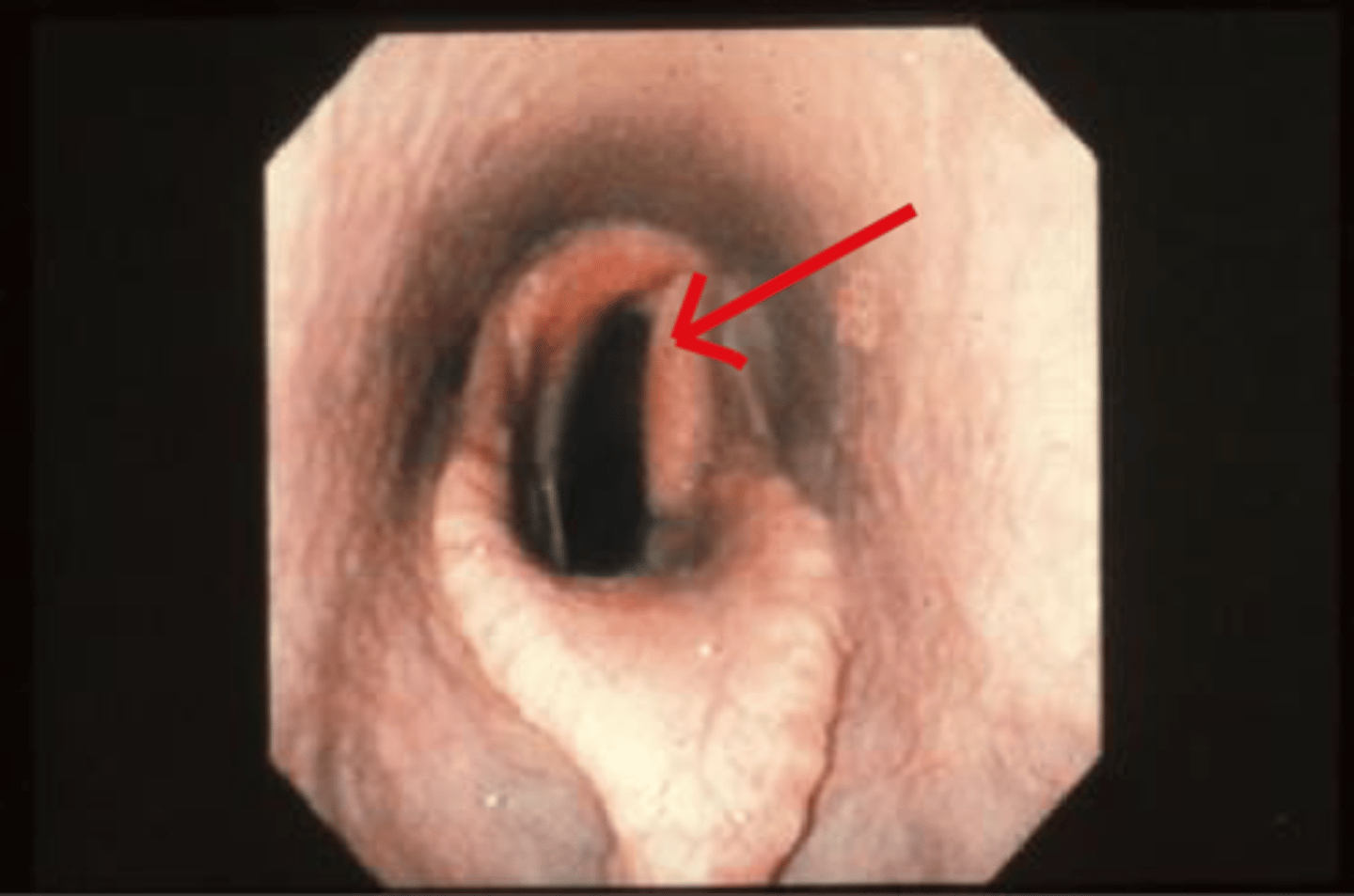
Bilateral laryngeal paralysis
What is this?
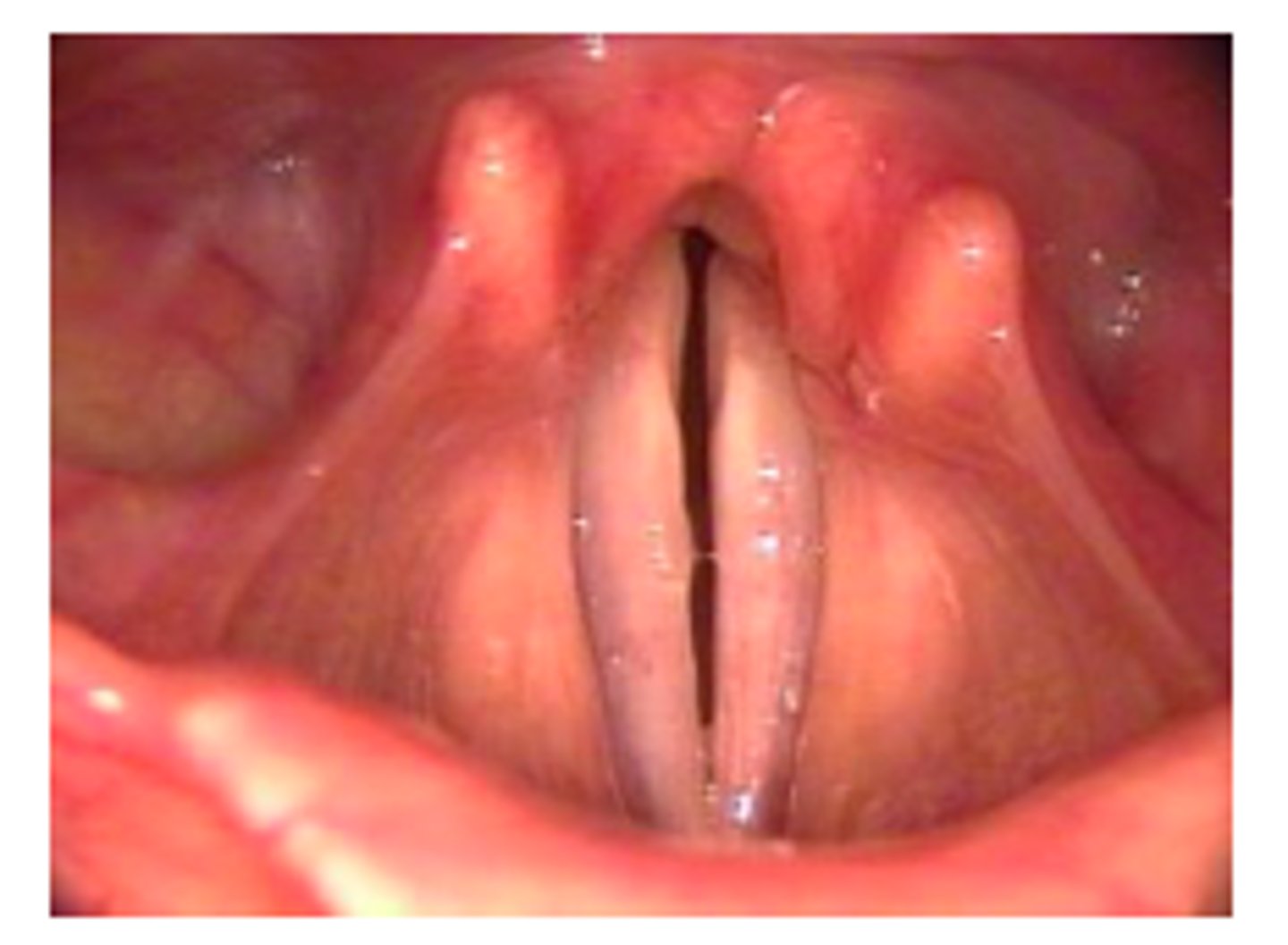
If mildly affected: just maintain a sedentary lifestyle and avoid excessive weight gain
How do you medically manage laryngeal paralysis?
Small dogs
Which are more successfully managed with medical therapy rather than surgery for laryngeal paralysis, large or small dogs?
Unilateral arytenoid lateralization and permanent tracheostomy
What are the two surgical treatments for laryngeal paralysis?
Unilateral arytenoid lateralization AKA Laryngeal Tie-Back Procedure
What is the treatment of choice of laryngeal paralysis?
Permanent tracheostomy
What is the "salvage" procedure for dogs most at risk of aspiration pneumonia due to laryngeal paralysis?
suture cricoid cartilage to muscular process of arytenoid
Describe the laryngeal tie back surgery or the unilateral arytenoid lateralization procedure:
Because it mimics the directional pull of the cricoarytenoid dorsalis muscle and rotates the arytenoid cartilage laterally
Why do you suture the cricoid cartilage to the muscular process of the arytenoid is a laryngeal tie back procedure?
FALSE: Advanced surgical referral is recommended
TRUE OR FALSE: The tie back procedure is simple and recommended that general practitioners do it so the dog can have the procedure done as soon as possible.
Laryngeal tie-back surgery aka Unilateral arytenoid lateralization
What is this, where the larynx is exposed, the thyropharyngeus muscle is exposed, cricothyroid and cricoarytenoid are separated, and suture is placed in muscular arytenoid to attach to cricoid/thyroid cartilage?
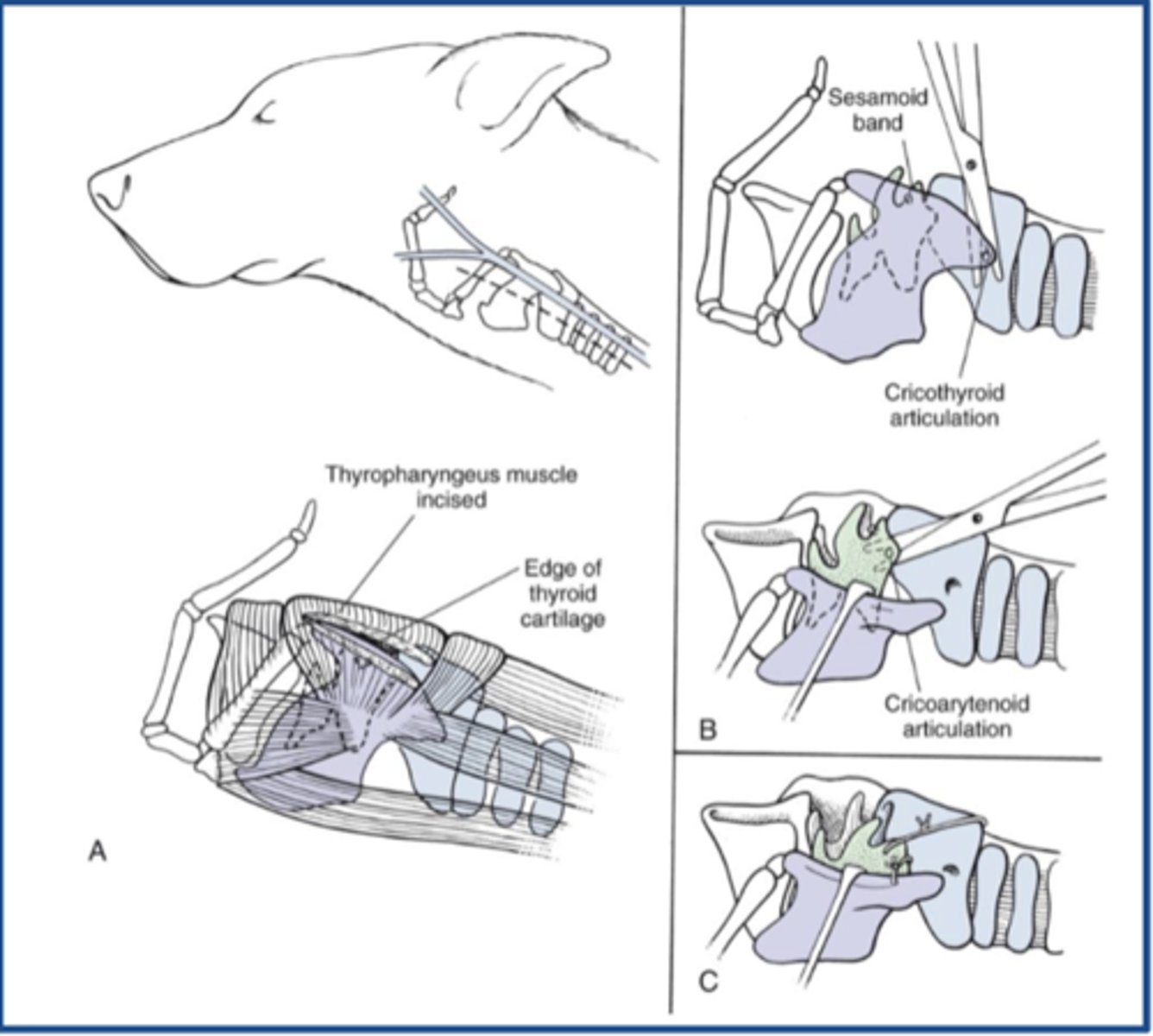
Their bark will be more quiet and hoarse
What do you need to tell the owner will be different about the dog after a Tie-Back procedure?
1. hematoma formation
2. swallowing discomfort
3. temporary glottic impairment
4. incisional issues
5. coughing after eating and drinking
7. aspiration pneumonia
List the early complications of suture lateralization:
If cartilages are insufficiently mineralized (younger) OR if they're TOO mineralized and crack causing failure (often older)
What problems may occur that will cause you to have to go back in, and tie-back the other side of the larynx since the one that you did isn't working?
10-20%
Aspiration pneumonia occurs in what amount of dogs with laryngeal paralysis?
Prognosis after unilateral lateralization is GOOD. Over 90% of patients have less respiratory distress and improved exercise tolerance (but doesn't get rid of symptoms)
Describe the prognosis for dogs having surgery for laryngela paralysis
Permanent tracheostomy
What is this, where you put a horizontal mattress in the sternohyoid musc. to elevate the trachea and create a stoma in the ventral tracheal wall by suturing the tracheal mucosa to the skin?
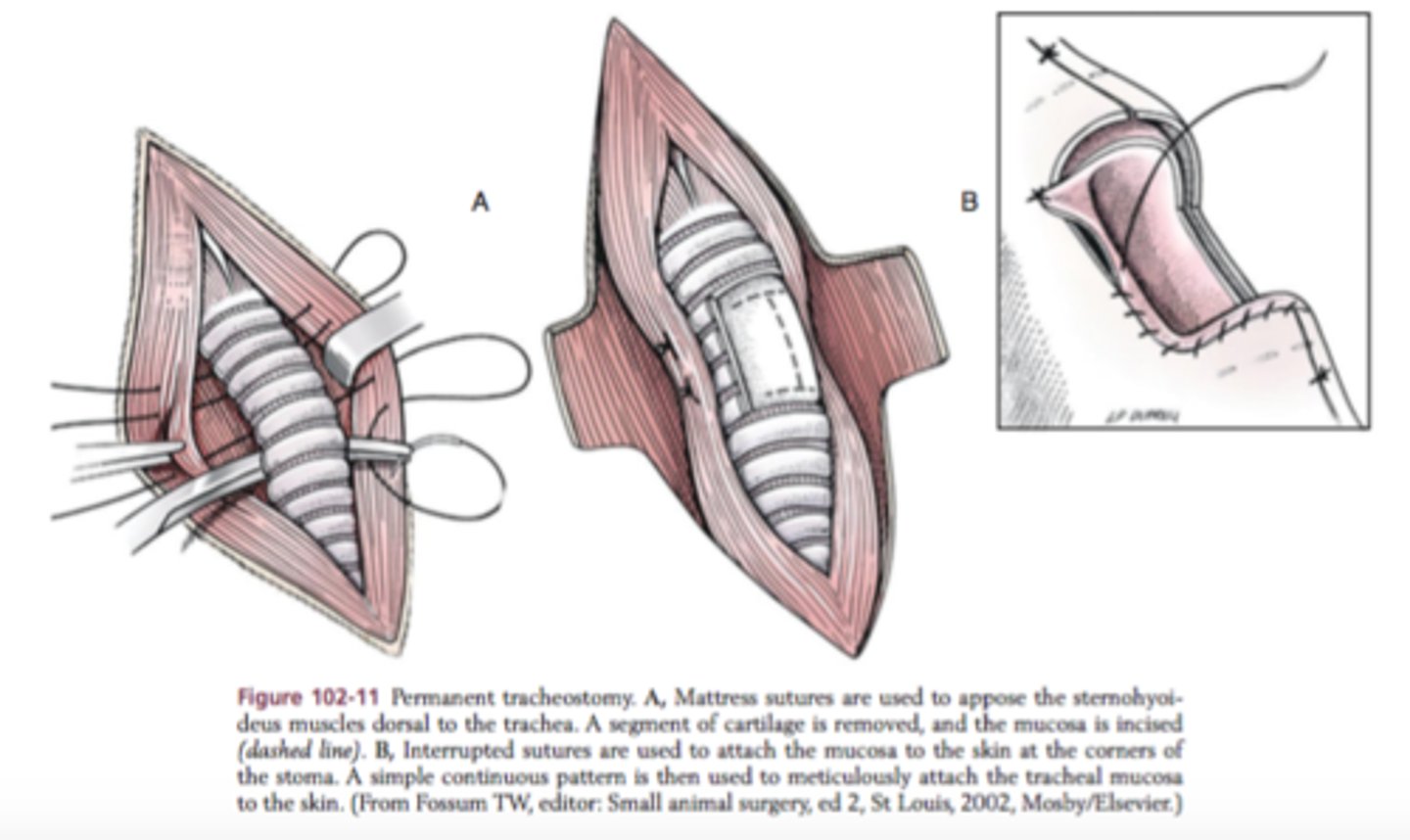
TIE BACK: suture cricoid cartilage to muscular process of arytenoid
PERMANENT TRACHEOSTOMY: suture tracheal mucosa to the skin
What is the difference between where you suture in a tie back procedure versus a permanent tracheostomy?
Permanent Tracheostomy
What is this?
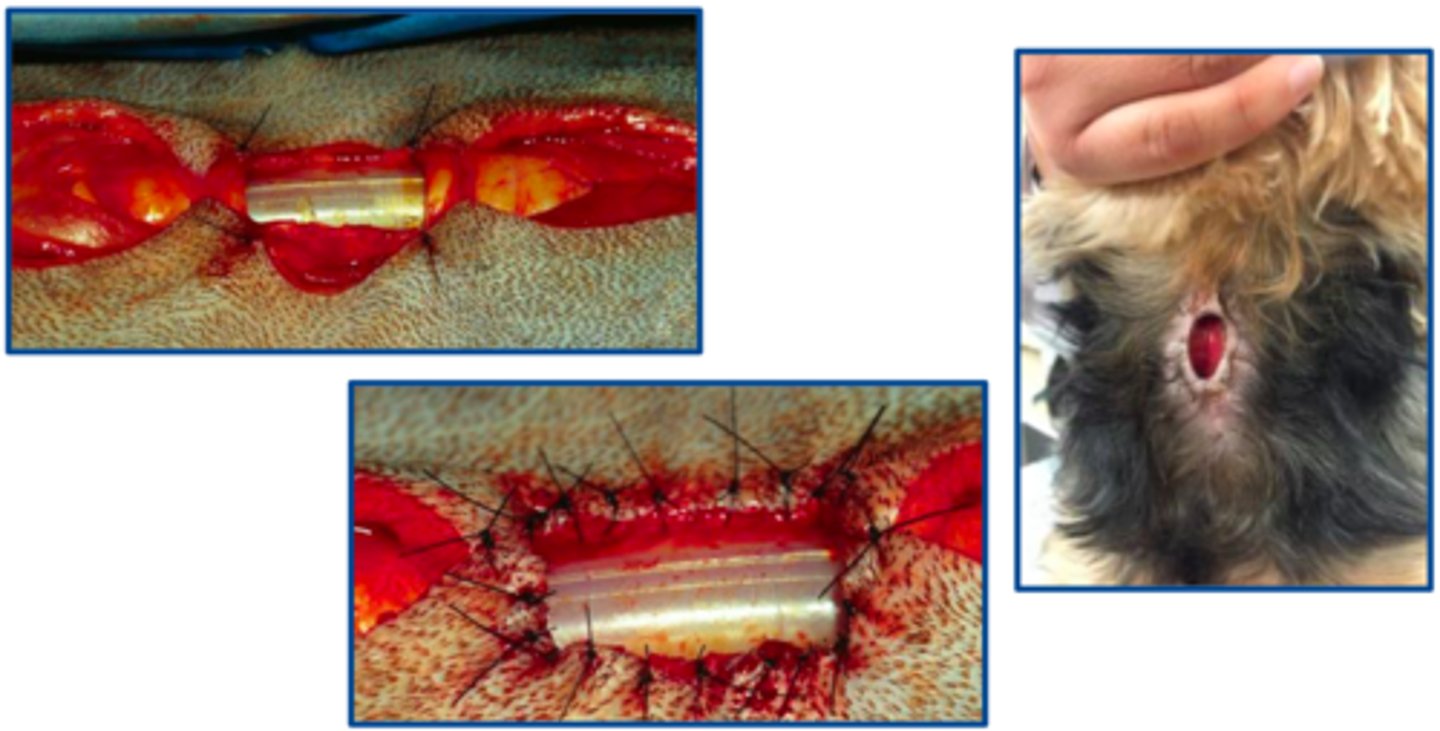
Dog MUST be restricted from swimming, there is inc. chance for respiratory infection, and ongoing care of the site will be necessary
What do you NEED to warn the owners about with permanent tracheostomy?
Aspiration pneumonia
What is the most COMMON complication of laryngeal paralysis tie back surgery?
Permanent tracheostomy
What is the best treatment for laryngeal paralysis animals that are at HIGH RISK for aspiration pneumonia?
Unilateral arytenoid lateralization
What is the treatment of choice for laryngeal paralysis?